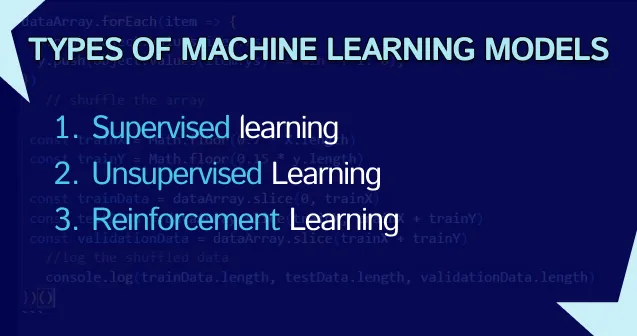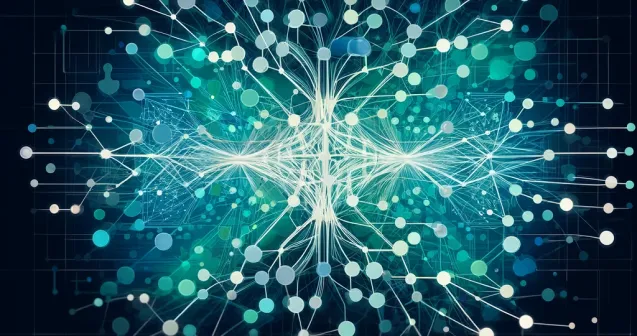
Types of Machine Learning Models: Explained with Examples
Explore the three main types of machine learning models—supervised, unsupervised, and reinforcement learning—with clear explanations and practical examples in TensorFlow.js.
· guides · 2 minutes
What Are the Different Types of Machine Learning Models?
Machine learning models can be categorized into three main types based on how they learn from data: supervised learning, unsupervised learning, and reinforcement learning. Each type is suited to specific tasks and has unique applications.
1. Supervised Learning
Definition: Supervised learning involves training a model on a labeled dataset, where each input has a corresponding output. The model learns to map inputs to outputs by minimizing the error between predictions and actual labels.
Common Use Cases:
- Classification: Predicting categories (e.g., spam detection in emails).
- Regression: Predicting continuous values (e.g., house price prediction).
Example in TensorFlow.js: Predicting house prices based on features like square footage and number of bedrooms.
import * as tf from '@tensorflow/tfjs';
// Datasetconst features = tf.tensor2d([[1000], [1500], [2000], [2500]]);const labels = tf.tensor2d([[300000], [450000], [600000], [750000]]);
// Modelconst model = tf.sequential();model.add(tf.layers.dense({ inputShape: [1], units: 1 }));
model.compile({ optimizer: 'sgd', loss: 'meanSquaredError' });
// Train the modelmodel.fit(features, labels, { epochs: 50 }).then(() => { // Predict model.predict(tf.tensor2d([[1800]])).print();});2. Unsupervised Learning
Definition: Unsupervised learning deals with unlabeled data. The model tries to find patterns or structure in the data, such as grouping similar items or reducing dimensionality.
Common Use Cases:
- Clustering: Grouping similar data points (e.g., customer segmentation).
- Dimensionality Reduction: Reducing the number of features while retaining information (e.g., PCA for image compression).
Example in TensorFlow.js: Clustering customers based on purchasing behavior.
import * as tf from '@tensorflow/tfjs';
// Sample datasetconst data = tf.tensor2d([ [1, 1], [2, 2], [3, 3], [10, 10], [11, 11], [12, 12],]);
// Using k-means clustering with TensorFlow.js isn't built-in but can be implemented.// Example: Centroid-based clusteringconst centroids = tf.tensor2d([ [2, 2], [11, 11],]);
// Assign data points to clusters (concept demonstration)data.sub(centroids.expandDims(0)).square().sum(-1).argMin(-1).print();3. Reinforcement Learning
Definition: Reinforcement learning trains a model to make decisions by interacting with an environment. The model learns to maximize rewards by trying different actions and observing the outcomes.
Common Use Cases:
- Game Playing: Training an agent to play games like chess or Go.
- Robotics: Teaching robots to perform tasks in dynamic environments.
Example in TensorFlow.js: Training an agent to maximize score in a simple grid environment.
import * as tf from '@tensorflow/tfjs';
// Simplified reinforcement learning setup// States: [0, 1, 2, 3] (positions on a grid)// Actions: [left, right]// Rewards: +1 for reaching state 3
const states = 4;const actions = 2;const qTable = tf.zeros([states, actions]);
// Simulate training: update Q-valuesconst learningRate = 0.1;const discountFactor = 0.9;
const updateQValue = (state, action, reward, nextState) => { const currentQ = qTable.gather([state]).gather([action]); const maxNextQ = qTable.gather([nextState]).max(); const newQ = currentQ.add( tf.scalar(learningRate).mul( tf.scalar(reward).add(tf.scalar(discountFactor).mul(maxNextQ)).sub(currentQ) ) ); qTable.scatterNDUpdate([[state, action]], [newQ]);};More posts
-

Tensor Operations in TensorFlow.js: Explained with Examples
Discover the concept of tensor operations in TensorFlow.js and learn about commonly used tensor operations through easy-to-understand examples.
-

Implementing a Convolutional Neural Network (CNN) in TensorFlow.js Using Tabular Data
Learn how to implement a convolutional neural network (CNN) in TensorFlow.js using a tabular dataset. This step-by-step guide covers data preprocessing, model architecture, training, and evaluation for binary classification tasks.
-

Creating a Simple Hello, TensorFlow Program
Learn how to create a simple "Hello, TensorFlow!" program in TensorFlow.js. A beginner-friendly guide to help you get started with TensorFlow.